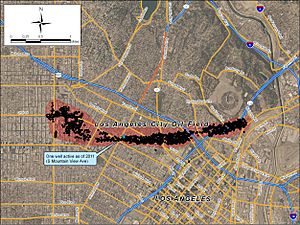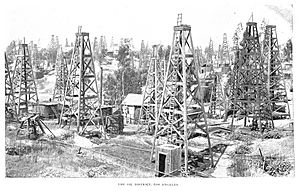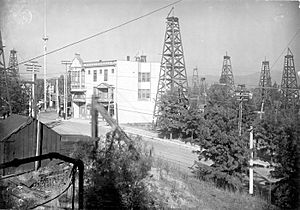Los Angeles City Oil Field facts for kids
Quick facts for kids Los Angeles City Oil Field |
|
|---|---|
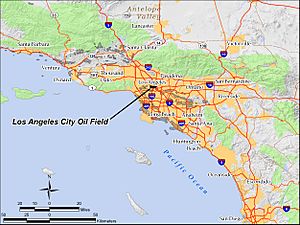
The Los Angeles City Oil Field in the Los Angeles Basin of southern California. Other oil fields are shown in light gray.
|
|
| Country | United States |
| Region | Los Angeles Basin |
| Location | Los Angeles County, California |
| Offshore/onshore | onshore |
| Operators | Numerous () |
| Field history | |
| Discovery | prehistoric |
| Start of development | 1857 |
| Start of production | 1890 |
| Peak year | 1901 |
| Production | |
| Current production of oil | 3.5 barrels per day (~170 t/a) |
| Year of current production of oil | 2019 |
| Estimated oil in place | 0 million barrels (~0 t) |
| Producing formations | Puente (Miocene) |
The Los Angeles City Oil Field is a big oil field located just north of Downtown Los Angeles. It stretches for about four miles (6 km) from south of Dodger Stadium to Vermont Avenue. This area, which used to produce a lot of oil, covers about 780 acres (3.2 km2).
This oil field was discovered in 1890. It became very famous in 1892 when Edward Doheny drilled a successful well. For a while, it was the top oil-producing field in California. In 1895, it produced more than half of all the oil in the state!
At its busiest in 1901, about 200 different oil companies were working here. Today, the entire area is covered by homes and businesses. As of 2011, only one oil well is still active. It's hidden behind a fence in the Westlake neighborhood. This well produces about 3.5 barrels of oil each day.
The money made from this field helped people find and develop other oil fields in the Los Angeles area. There were once about 1,250 wells drilled here. A "forest" of tall oil derricks (the structures used for drilling) once covered the hills. Now, almost no signs of them remain.
Contents
Where is the Los Angeles City Oil Field?
The Los Angeles City field is one of many oil fields in the Los Angeles Basin. To the west, you can find the Salt Lake and Beverly Hills fields, which still produce oil. The Los Angeles Downtown Oil Field is to the south.
The land around the Los Angeles City field has gentle hills and small valleys. The height above sea level ranges from about 250 to 500 feet (76 to 152 m). The highest spots are in Elysian Park, near Dodger Stadium.
This part of Los Angeles is very developed. You'll see many apartment buildings, shops, and small factories. U.S. Highway 101 (the Hollywood Freeway) runs along the north side of the field. California State Route 110 (the Arroyo Seco Parkway), which was the first freeway in the United States, cuts through the eastern part of the field.
The neighborhoods that cover the field include Koreatown, Westlake, Echo Park, Chinatown, and Elysian Park.
Some important places built right on top of the old oil field include Shriners Hospital for Children, St. Vincent Medical Center, Belmont High School, and the Edward R. Roybal Learning Center.
How Oil is Trapped Underground
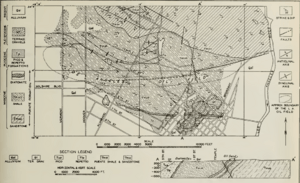
The oil in the Los Angeles City field is found fairly close to the surface. All the oil that has been produced comes from a single rock layer called the Miocene-age Puente Formation. On top of this formation, there's a thin layer of younger soil and rock.
The field's structure is like a folded rock layer with cracks, called a faulted anticline. The oil is trapped in layers of sand that dip downwards. In some places, the oil is stopped by a crack in the rock (a fault). In other places, it reaches the surface as natural tar seeps.
Oil is trapped in different ways here. Sometimes, the sand layers get thinner or change, trapping the oil. Other times, the oil is blocked by solid rock layers that moved into place because of faults.
There are three main oil-producing zones, or levels, within the Puente Formation. They are called the First, Second, and Third zones. On average, these zones are found at depths of 900 feet (274 m), 1,100 feet (335 m), and 1,500 feet (457 m) below the surface. Even though some wells were drilled much deeper, no large amounts of oil were found at those greater depths.
The oil found here is generally "heavy," meaning it's thick and sticky. It was mostly used as fuel oil in the early 1900s. It was also sprayed on the city's dirt roads to keep the dust down.
A Look at the Field's History and Production
Early Discoveries and the Oil Boom
People have known about the natural tar seeps in this area for a very long time. Native Americans used the tar for waterproofing. Spanish settlers used it for lamps, sealing roofs, and greasing wagon wheels.
The first known well, called the "Dryden Well," was dug by hand in 1857. It produced some heavy oil and tar. The growing town of Los Angeles bought this product to oil its streets.
In 1890, some drillers, including Maltman and Ruhland, successfully started producing a few barrels of oil a day. But it was Edward Doheny and Cannon's well, started in November 1892, that made the field famous. They dug a well to 155 feet (47 m) but stopped because of bad gas. However, the oil seeps they found encouraged them to keep going. Doheny used a sharpened eucalyptus log as a makeshift hammer to dig deeper. Soon, they hit an oil pocket and started producing about seven barrels a day!
Their first well was in an area with hundreds of small town lots. Since there were no rules about how far apart wells had to be, anyone with a small piece of land and enough money could drill a well and potentially get rich. Everyone wanted to get their well working before their neighbors drained the oil!
Within a year of Doheny's well, there were 121 wells on the field, mixed in with homes and businesses. By the end of 1895, the field was producing 2,000 barrels of oil a day. It accounted for 60% of all the oil produced in California! The field kept growing, and by the end of 1897, over 550 wells had been drilled, producing over a million barrels of oil in total.
The "Oil Queen" and Peak Production
In the early days, no single company controlled the field. Many small companies started up, and the Los Angeles Stock Exchange even had a special section just for oil stocks.
The most successful person on the field was a piano teacher from Kentucky named Emma Summers. She became known as the "Oil Queen of California." She bought half of an oil well for $700 using money from her piano lessons. As her wells did well, she bought more, sometimes forcing other operators out of business. She sold her oil to power companies, hotels, and other businesses. She even did her own accounting and still taught piano lessons at night! When oil prices were high, she controlled about half of the wells in the central part of the field.
The peak year for the field was 1901. During this year, 1,150 wells were actively pumping over 1.8 million barrels of oil. More than 200 different companies were working there. After 1915, very few new wells were drilled. Production quickly went down because there were too many wells trying to get oil from a limited supply underground.
The early years weren't always smooth. In 1907, a huge oil tank near Echo Lake broke. Crude oil flowed into the lake and caught fire, burning for three days! The lake is now part of Echo Park. There were also problems with oil thieves, stolen tools, and people trying to sabotage their competitors' wells.
Because there weren't many rules back then, records were sometimes incomplete. Many wells were drilled and then abandoned without a trace. By 1961, most of the oil field area was being redeveloped for homes. Only 93 wells were still active then. Over time, almost all of them have been shut down, leaving just the one quiet well pumping today.
Images for kids
-
The Los Angeles City Oil Field in the Los Angeles Basin of southern California. Other oil fields are shown in light gray.


